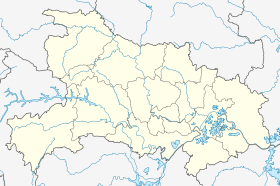Wuxue
Wuxue (Chinese: 武穴; pinyin: Wǔxué), formerly Guangji County (simplified Chinese: 广济县; traditional Chinese: 廣濟縣; pinyin: Guǎngjì Xiàn; Postal Romanization: Kwangtsi), is a county-level city on the north shore of the Yangtze River in eastern Hubei province, People's Republic of China. Wuxue falls under the administration of the prefecture-level city of Huanggang.
Wuxue 武穴市 Wusueh | |
|---|---|
 Wuxue High School Main Gate (武穴中学校门) | |
 Wuxue Location in Hubei | |
| Coordinates (Wuxue government): 29°50′38″N 115°33′40″E | |
| Country | People's Republic of China |
| Province | Hubei |
| Prefecture-level city | Huanggang |
| Area | |
| • County-level city | 1,241.7 km2 (479.4 sq mi) |
| • Urban | 31.00 km2 (11.97 sq mi) |
| Population (2017)[1] | |
| • County-level city | 864,000 |
| • Density | 700/km2 (1,800/sq mi) |
| • Urban | 293,000 |
| Time zone | UTC+8 (China Standard) |
| Website | 武穴市人民政府门户网站 (Wuxue City People's Government Web Portal) (in Simplified Chinese) |
Geography
Wuxue's total population is about 580,000 and the city extends over 1,200 square kilometres (460 sq mi), almost all of which is cultivated.
The city has Mount Lu to the east, is close to the Qizhou hometown of famed ancient pharmacist Li Shizhen in neighboring Qichun County in the west, borders the Yangtze River in the south, and leans against the Dabie Shan mountain range in the north.
Wuxue is 220 kilometers downriver from the provincial capital of Wuhan and about 50 kilometers upriver from the port of Jiujiang City, on the south side of the Yangtze in Jiangxi province.
Administrative divisions
Wuxue administers four subdistricts and eight towns:[2][3][4]
| # | Name | Chinese (S) | ||||
|---|---|---|---|---|---|---|
| Subdistricts | ||||||
| 1 | Wuxue Subdistrict | 武穴街道 | ||||
| 2 | Kanjiang Subdistrict | 刊江街道 | ||||
| 3 | Tianjiazhen Subdistrict (Tianzhen) | 田家镇街道 (田镇街道) | ||||
| 4 | Wanzhanghu Subdistrict | 万丈湖街道 | ||||
| Towns | ||||||
| 5 | Meichuan Town | 梅川镇 | ||||
| 6 | Yuchuan Town | 余川镇 | ||||
| 7 | Huaqiao Town | 花桥镇 | ||||
| 8 | Dajin Town | 大金镇 | ||||
| 9 | Siwang Town | 四望镇 | ||||
| 10 | Shifosi Town | 石佛寺镇 | ||||
| 11 | Dafasi Town | 大法寺镇 | ||||
| 12 | Longping Town | 龙坪镇 | ||||
History
Wuxue opened as a port towards the end of the 16th century. Upon China signing the 1876 Yantai treaty with Britain, foreign merchants established an upgraded wharf.
The port's strategic advantage lies in its proximity to the juncture of three provinces — Hubei, Anhui, and Jiangxi — and serves as a central hub for commodity trade.
The port was modernized in 1953, with further-enhanced navigational improvements in 1975 and 1980. The total length of the port waterfront is now 14 kilometers, with 23 quay berths and many large warehouses, hoists, and cranes. The port handles both commodity and passenger traffic.
Transportation
In addition to the port, Wuxue is known as the "Gateway to Three Provinces" (mentioned above). As well, it is served by the east-west inter-provincial Shanghai-Hibiscus Expressway, and is a major station on the Beijing-Guangzhou railway. A passenger ferry runs across the river and downstream to Jiujiang, and Wuxue is about one hour by car from Jiujiang airport.
References
- Ministry of Housing and Urban-Rural Development, ed. (2019). China Urban Construction Statistical Yearbook 2017. Beijing: China Statistics Press. p. 66. Retrieved 11 January 2020.
- 行政区划 (in Chinese). Wuxue People's Government. 29 November 2016. Retrieved 7 January 2018.
全市行政区划调整为3街道办事处、8镇(包含1个农场)。分别是武穴街道办事处、刊江街道办事处、田家镇街道办事处、梅川镇、余川镇、花桥镇、大金镇、四望镇、石佛寺镇、大法寺镇、龙坪镇(包含国营万丈湖农场区域)。2004年11月,经省人民政府批准,设立万丈湖街道办事处,其行政区域为原国营万丈湖农场辖区,驻地新港,同时经市人民政府批准,设立黄湖村、太泊村、万丈湖村和新港社区居委会。至2005年,全市行政区划为4街道办事处、8镇。
- "黄冈市乡镇(街道)名录" [Huanggang City Township-level Divisions List] (in Chinese). XZQH.org. 15 August 2014. Retrieved 7 January 2018.
武穴市辖4个街道、8个镇:武穴街道、刊江街道、田镇街道、万丈湖街道、梅川镇、余川镇、花桥镇、大金镇、石佛寺镇、四望镇、大法寺镇、龙坪镇。
- 中国地质邮政编码簿(2015). China Post. 2015. p. 595.